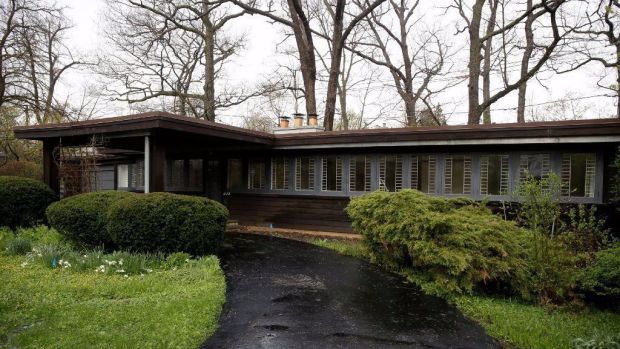After the name of a racist owner was stripped from a Frank Lloyd Wright-designed cottage in Glencoe, leaders and residents of the suburb said they supported the decision, with many expressing regret that such attitudes existed a century ago.
The Glencoe Historical Society announced recently the removal of Sherman Booth’s name from a cottage in the Ravine Bluff subdivision. The historical society took the action following the discovery that Booth, who was Frank Lloyd Wright’s attorney and friend, led an effort to lower the number of Black, Italian and Greek residents in the wealthy North Shore village just over a century ago by employing racially restrictive covenants in real estate practices.
The cottage is now called the Ravine Bluffs Cottage.
While aware of a significant decline in Glencoe’s Black population in the 1920s, historical society officials said they did not become aware of Sherman Booth’s tactics until they conducted research for an ongoing exhibit detailing the history of Blacks in the village.
That Booth engaged in such behavior was a surprise for historical society board members including Hilde Carter, a Black woman who lived in Glencoe for about 25 years when her parents bought a house in the village in 1952.
“The whole organization was disappointed because we had no clue who this guy was,” Carter said.
Carter spoke of her experiences growing up in the area and the discrimination she sensed in a community where few Blacks lived.
“As a child you do not process your environment in the same way you do as an adult,” she said. “As I got to be older I knew we lived in a segregated area, but the whole world was segregated then. I didn’t know the factors of why it was segregated and how it became segregated until the exhibit.”
Carter added she believes many of the same issues she encountered growing up still remain today.
“As a person of color living on the (North) Shore you always get invalidated from the standpoint of people look at you like ‘why are you here?’ as they don’t expect you to be here,” she said. “That’s been a reality all my life and to this day it has been the same thing.”
Village President Howard Roin labeled the revelations regarding Booth as “embarrassing.”
“It is important as we look back a century not to hold people to today’s standards but enough was known then that what was going on then was not acceptable. Clearly this was not right,” he said. “In the 1920s there were plenty of people that should have known that this type of bigotry was not OK, and Booth was on the wrong side of that.”
Roin, who is a longtime resident of the village, believes there has been some change in making Glencoe a more welcoming community.
“It is not something that we do anymore and we are working hard to make sure that we are an inclusive place,” he said.
Uncovering Booth’s practices marked another chapter in the recent history of the one-story cottage designed in 1913 by Wright and planned to be a temporary residence for the Booth family.
Several years ago, preservationists voiced concern about the future of the cottage as the new owners expressed interest in razing it allowing for new construction. Landmarks Illinois, a preservation advocacy organization, subsequently placed it on the 2019 Most Endangered Historic Places in Illinois list.
Eventually, a deal was made whereby the historical society took possession of the cottage and physically moved it in July 2020 about a quarter mile away to land owned by the Glencoe Park District at 301 Maple Hill Road.
Landmarks Illinois Advocacy Manager Kendra Parzen said her organization was not aware of Booth’s involvement in the racially-restrictive covenants when it placed the cottage on the endangered list.
A cottage in Glencoe’s Ravine Bluffs neighborhood designed by Frank Lloyd Wright is pictured on May 1, 2019. The Glencoe Historical Society changed its name to Ravine Bluffs Cottage after discovering that its former namesake, Sherman Booth, wrote and enforced racially restrictive covenants in the North Shore suburb around the 1920s. (Stacey Wescott/Chicago Tribune)
With Booth’s history now uncovered, Parzen said Landmarks Illinois supported the decision to remove the name and will update their own website and materials to reflect the new name.
“It is a good teaching moment for other local history and preservation organizations,” she said. “While looking at our past we are going to find legacies that are immoral and unjust. The (historical society) was right to share their research and change the name of the cottage.”
John Waters, the preservation programs director at the Frank Lloyd Wright Building Conservancy. also endorsed the historical society decision.
“How a site chooses to name itself is not necessarily how historians will choose to write about it if it is written about. It is simply the choice of the owner of how they want to interpret the site. In that sense we support it, because we have changed it on our site as well,” Waters said.
Besides Blacks, Greeks and Italians also faced discrimination due to the racially-restrictive covenants, according to Karen Ettelson, the Glencoe Historical Society co-president.
“Initially, the restrictive covenants were directed toward non-Caucasians and I think the definition of Caucasian at that time excluded a lot of the Mediterranean cultures like Italians and Greeks,” she explained. “The restrictive covenants became more specific as the purchases went forward so the initial ones said non-Caucasian but then they were very specific towards (Blacks) as well as Italians and Greeks.”
That did not shock Carla Simonini, former Rubino Endowed Professor of Italian American Studies at Loyola University of Chicago.
She said she was aware of racially restrictive covenants specifically aimed at Italians, but quickly added, “Knowing what the atmosphere was like in the 1920s, it wasn’t too surprising that they would be included in that group,” she said.
Racially-restrictive covenants were ruled to be unenforceable by the U.S. Supreme Court in 1948.




